Nepal Travel offers a unique blend of adventure and culture, and SIXT.VN is here to ensure your trip is seamless and unforgettable. Whether you’re dreaming of trekking in the Himalayas or exploring ancient temples, understanding a few key aspects can significantly enhance your experience.
1. Is Kathmandu A Sensory Overload For First-Time Nepal Travelers?
Yes, Kathmandu can be a sensory overload for first-time visitors, but embracing the chaos is part of the experience. Kathmandu, the bustling capital of Nepal, is known for its vibrant culture and chaotic atmosphere, which can be overwhelming initially. According to a 2023 report by the Nepal Tourism Board, visitor feedback often mentions the initial shock of the city’s intensity. However, with a bit of acclimatization, you’ll find that Kathmandu’s sensory overload is a rewarding introduction to Nepal’s vibrant culture.
- Embrace the Chaos: Don’t be surprised by the crowded streets, blaring horns, and a mix of enticing and less appealing smells. This is all part of Kathmandu’s charm.
- Acclimatize Gradually: Start with a few hours in a quieter area, such as a Western-style coffee shop in Thamel, before venturing into the more crowded areas.
- Explore with a Companion: Initially, explore the city with a partner or a guide to get your bearings.
- Venture Out Solo: Once you feel more comfortable, explore on your own with your camera to capture the city’s unique vibrancy.
- Be Open to New Experiences: Kathmandu is an assault on the senses, but it’s also a place where you’ll find incredible vibrancy and cultural richness.
Kathmandu’s vibrant Buddhist and Hindu communities create a sensory-rich environment that activates all senses, offering a unique and rewarding experience.
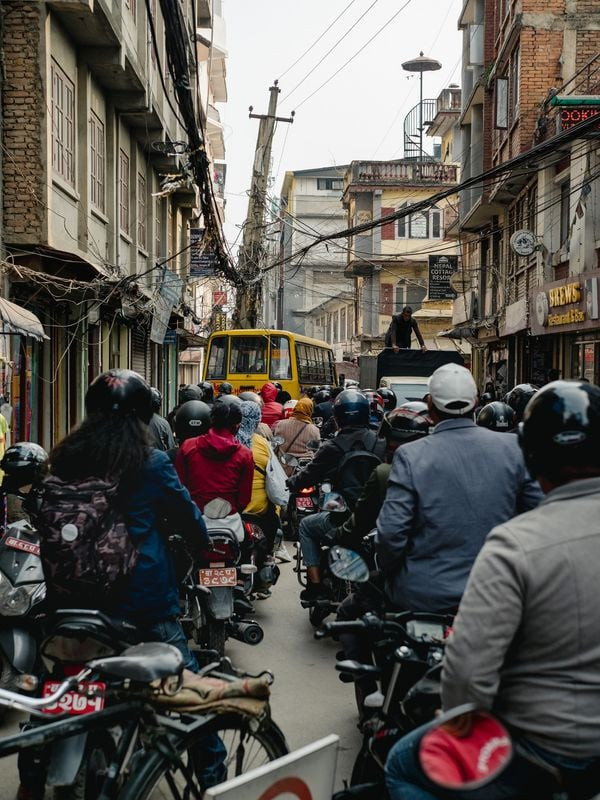 Don
Don
Alt text: Busy street scene in Kathmandu, Nepal, showcasing the intense traffic and vibrant atmosphere.
2. How Reliable Is Public Transport For Nepal Travel?
Public transport in Nepal can be an adventure in itself, offering a unique and immersive experience, though it may not always be the most reliable option. Buses are often brightly decorated and filled with local music, creating a memorable journey.
- Expect the Unexpected: Public buses can be crowded, and the ride can be bumpy, especially on mountain roads. Be prepared for delays and stops along the way.
- Cultural Immersion: Enjoy the cultural experience, from the incense wafting from the dashboard to the musicians who hop on to entertain passengers.
- Safety Considerations: Be aware that safety standards may not be as high as in Western countries. Roads can be narrow and winding, and accidents can occur.
- Time Commitment: Long-distance travel by bus can take the entire day. Allow plenty of buffer time for unexpected delays.
- Snacks and Water: Pack enough snacks and water for the journey, as stops may be infrequent.
Despite the potential challenges, public transport offers an authentic glimpse into local life and can be a cost-effective way to travel.
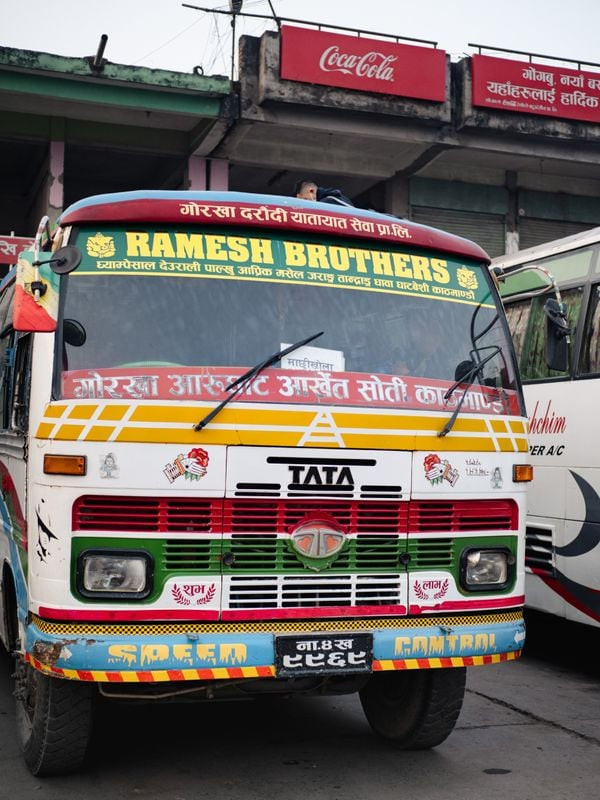 A brightly-coloured bus, preparing for a long journey to Jagat. Photo: Sarah Hewitt
A brightly-coloured bus, preparing for a long journey to Jagat. Photo: Sarah Hewitt
Alt text: A colorful local bus in Nepal, ready for a long journey, exemplifying Nepal’s public transport system.
3. Can I Organize My Nepal Travel Completely In Kathmandu?
Yes, you can organize almost everything for your Nepal travel directly in Kathmandu, making it ideal for spontaneous travelers. Upon arrival at Tribhuvan Airport, you can easily obtain a tourist visa (though expect potential queues), and SIM cards are readily available with on-the-spot setup assistance.
- Visa on Arrival: Obtain a tourist visa at the airport if you haven’t done so online.
- SIM Cards: Purchase a local SIM card at the airport for easy communication.
- Trekking Supplies: Stock up on trekking essentials in Thamel, including medication, water purification tablets, and gear.
- Tour and Trekking Arrangements: Arrange treks, tours, and transportation within the city through local agencies.
- Flexibility: Kathmandu offers the flexibility to plan your itinerary based on current conditions and local advice.
Kathmandu’s comprehensive services cater to every traveler’s needs, allowing you to tailor your adventure as you go.
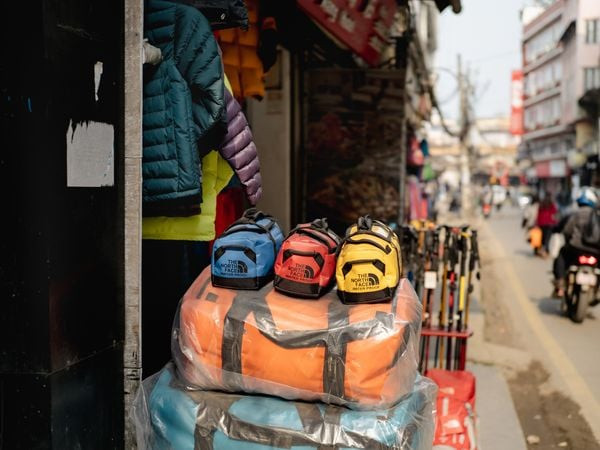 Thamel. The markets of Kathmandu are well-stocked for hikers. Photo: Sarah Hewitt
Thamel. The markets of Kathmandu are well-stocked for hikers. Photo: Sarah Hewitt
Alt text: Well-stocked markets in Thamel, Kathmandu, providing hikers with all essential gear and supplies.
4. How Does Nepal’s Ever-Changing Landscape Impact Travel Plans?
Nepal’s landscape is constantly evolving due to natural events and development, impacting travel plans. The 2015 earthquake and ongoing infrastructure projects mean that the country is in a state of continuous change.
- Rebuilding Efforts: Be aware that rebuilding efforts from the 2015 earthquake are still evident.
- Landslides and Floods: Expect to encounter landslides and washed-out bridges, particularly during the monsoon season.
- Infrastructure Development: Note that infrastructure development, such as road construction on the Manaslu Circuit, may alter the trekking experience.
- Weather Variability: Prepare for unpredictable weather, especially in the mountains. Pack for all eventualities, including warm layers and waterproof gear.
- Adaptability: Be flexible with your plans and prepared to adapt to changing conditions.
The dynamic nature of Nepal means that each visit can offer a unique experience, requiring travelers to stay informed and adaptable.
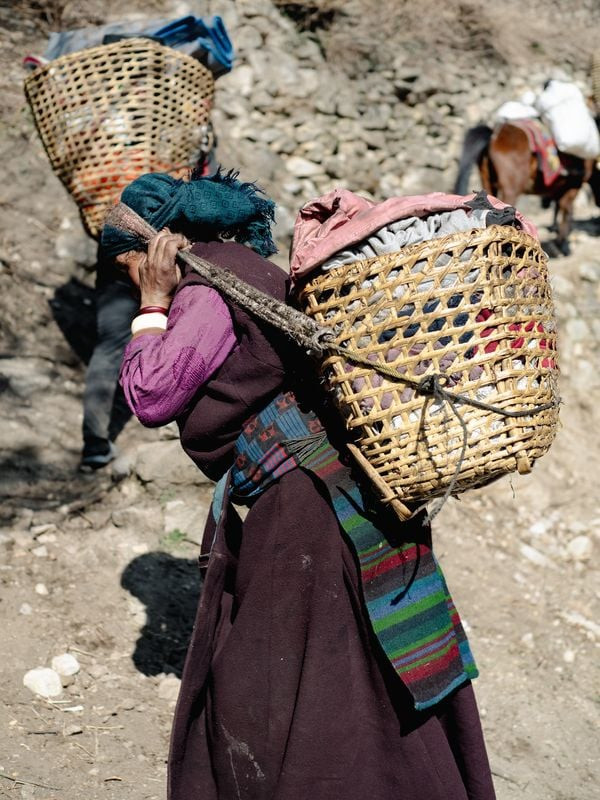 A local, photographed between Namrung and Leo on the Manuslu Circuit. Photo: Sarah Hewitt
A local, photographed between Namrung and Leo on the Manuslu Circuit. Photo: Sarah Hewitt
Alt text: A local resident photographed along the Manaslu Circuit, highlighting the remote and changing landscapes of Nepal.
5. What Are The Key Differences Between Urban And Rural Life During Nepal Travel?
Key differences between urban and rural life in Nepal significantly impact the travel experience. Cities like Kathmandu and Pokhara offer modern amenities, while rural areas provide a more traditional and basic way of life.
- Cities:
- Kathmandu and Pokhara offer cafes, shops, and Wi-Fi.
- Kathmandu is culturally rich, while Pokhara has a relaxed, backpacker vibe.
- Rural Areas:
- Basic amenities with standardized menus in teahouses.
- Limited Wi-Fi access, encouraging disconnection and appreciation of nature.
- Focus on essential supplies like biscuits and toilet paper being exciting finds.
- Preparation: Stock up on supplies and immerse in culture in cities before trekking.
- Pace of Life: Embrace the slower pace and simplicity of rural life, disconnecting from technology.
Understanding these differences allows travelers to prepare for varying levels of comfort and immerse themselves in the distinct experiences Nepal offers.
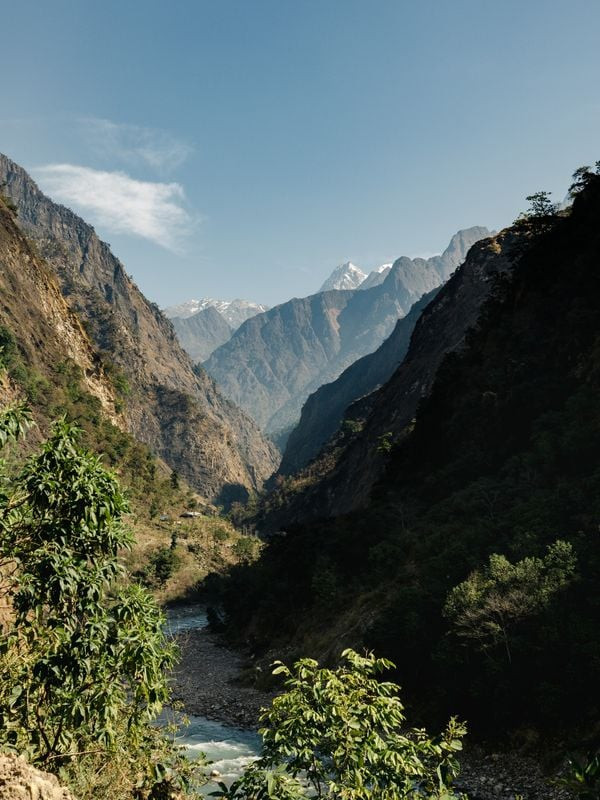 A Nepali landscape, just beyond the Jagat trailhead. Photo: Sarah Hewitt
A Nepali landscape, just beyond the Jagat trailhead. Photo: Sarah Hewitt
Alt text: Serene Nepali landscape near Jagat trailhead, illustrating the tranquil and simple rural life distinct from urban centers.
6. How Does Daily Life In The Open Impact Cultural Experiences During Nepal Travel?
Daily life in Nepal often unfolds in the open, offering unique cultural experiences that can be both enlightening and challenging. Observing daily rituals and activities provides insight into Nepali culture.
- Public Life: Be prepared to witness events that might be considered private in other cultures, such as funeral pyres.
- Ethical Considerations: Reflect on the ethics of documenting such moments as a traveler and photographer.
- Tourism Impact: Be mindful of the impact of tourism, including litter and environmental concerns.
- New Perspectives: Embrace the opportunity to see the world from a different perspective.
- Responsibility: Pack out your rubbish and minimize your environmental impact.
This openness provides a deeper understanding of Nepali life, encouraging travelers to be respectful and mindful of their impact.
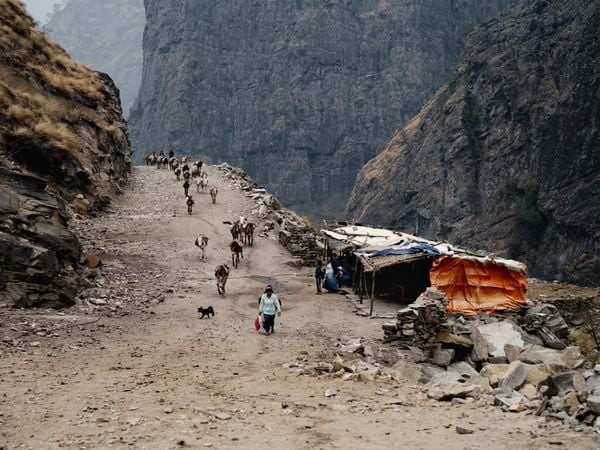 Life if slow moving, simple, and lived outdoors in the Jagat Valley. Photo: Sarah Hewitt
Life if slow moving, simple, and lived outdoors in the Jagat Valley. Photo: Sarah Hewitt
Alt text: Slow-paced, simple life lived outdoors in Jagat Valley, Nepal, capturing the essence of Nepali daily life.
7. What Kind Of Interactions Can You Expect With Locals During Nepal Travel?
Expect warm, friendly, and memorable interactions with locals during your Nepal travel. Despite being a popular trekking destination, Nepal offers numerous opportunities to connect with its people.
- Hospitality: Be open to meeting locals who are eager to share their stories, smiles, and hospitality.
- Cultural Immersion: Join in local activities such as sunrise walks to monasteries or dinners in family homes.
- Cooking Classes: Take cooking classes to learn about Nepali cuisine and culture.
- Community Tours: Participate in tours of Tibetan exile communities to gain insight into Nepal’s diverse cultural landscape.
- Unforgettable Moments: These interactions will make your journey unique and memorable.
Whether through shared meals, cultural experiences, or simple conversations, the warmth of the Nepali people will leave a lasting impression.
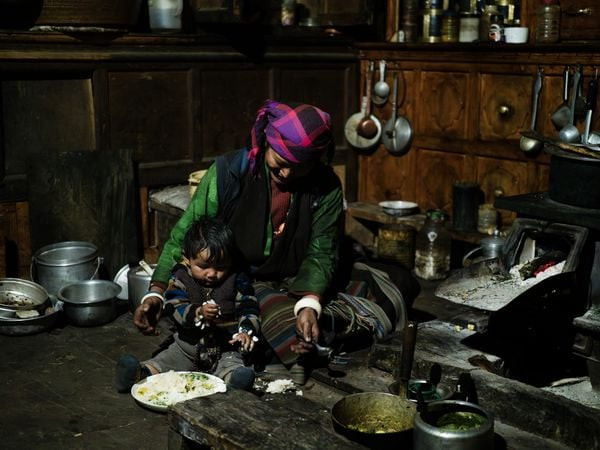 Teahouse host Bima and her son Tutankhamen in Ripchet, Tsum Valley Photo: Sarah Hewitt
Teahouse host Bima and her son Tutankhamen in Ripchet, Tsum Valley Photo: Sarah Hewitt
Alt text: Teahouse host Bima and her son Tutankhamen in Ripchet, Tsum Valley, exemplifying the warm hospitality of Nepali locals.
8. What Is The Significance Of “Dal Bhat Power” For Nepal Travel?
“Dal Bhat Power” is a saying among guides and porters in Nepal, emphasizing the nutritional value and sustained energy provided by the traditional dal bhat meal. Dal bhat is a staple dish consisting of lentil soup (dal) and rice (bhat), often served with vegetables and pickles.
- Nutritional Value: Dal bhat provides a balanced combination of carbohydrates, protein, and fiber.
- Sustained Energy: It offers sustained energy for trekking and physical activities.
- Cultural Significance: It is a fundamental part of Nepali cuisine and culture.
- Adaptability: Eaten twice daily, it keeps locals energized.
- Local Wisdom: The saying reflects the local wisdom of relying on simple, nutritious food for strength.
This traditional meal is essential for anyone undertaking strenuous activities in Nepal, highlighting the connection between food and endurance.
9. How To Respect Local Customs And Traditions During Nepal Travel?
Respecting local customs and traditions during your Nepal travel is crucial for a meaningful and positive experience. Nepal has a rich cultural heritage, and showing respect enhances your interactions with locals.
- Dress Modestly: Dress modestly, especially when visiting religious sites.
- Remove Shoes: Remove shoes before entering temples and homes.
- Photography: Ask for permission before taking photos of people.
- Public Displays of Affection: Avoid public displays of affection.
- Left Hand: Use your right hand for eating and giving gifts, as the left hand is considered unclean.
- Bargaining: Bargain respectfully when shopping.
- Temples: Walk clockwise around temples and prayer wheels.
- Monasteries: Be quiet and respectful in monasteries.
- Gestures: Avoid pointing with a single finger; use an open hand gesture.
- Offerings: Make small offerings at temples.
- Greetings: Greet people with “Namaste” (placing hands together).
- Attitude: Maintain a respectful and patient attitude.
Being mindful of these customs ensures a respectful and enriching travel experience in Nepal.
10. What Essential Packing Items Should I Include For Nepal Travel?
Packing the right items is crucial for a comfortable and safe Nepal travel experience, especially when trekking or exploring remote areas.
- Clothing:
- Moisture-wicking shirts
- Warm fleece jacket
- Waterproof and windproof jacket
- Hiking pants
- Thermal base layers
- Down jacket (for high altitudes)
- Comfortable walking shoes or hiking boots
- Sandals or flip-flops
- Socks (wool or synthetic)
- Hat and gloves
- Sun hat
- Gear:
- Backpack (30-50 liters)
- Daypack (for daily excursions)
- Headlamp or flashlight
- Water bottle or hydration reservoir
- Water purification tablets or filter
- Trekking poles
- Sunglasses
- Sunscreen
- Personal Items:
- Travel-sized toiletries
- First-aid kit
- Insect repellent
- Hand sanitizer
- Wet wipes
- Medications (altitude sickness, diarrhea relief)
- Toilet paper
- Quick-drying towel
- Documents:
- Passport
- Visa
- Travel insurance information
- Copies of important documents
- Airline tickets
- Miscellaneous:
- Camera and extra batteries
- Power bank
- Universal adapter
- Snacks
- Books or entertainment
- Dry bags (to protect electronics)
Packing these essentials ensures you are well-prepared for the diverse conditions and activities Nepal offers.
Discover Nepal with SIXT.VN: Your Gateway to Unforgettable Adventures
Are you ready to embark on an extraordinary journey to Nepal? SIXT.VN is your trusted partner for creating seamless and unforgettable travel experiences. We understand the challenges of planning a trip to Nepal, from navigating the bustling streets of Kathmandu to trekking in the majestic Himalayas. That’s why we offer a comprehensive range of services designed to cater to your every need.
Why Choose SIXT.VN for Your Nepal Travel?
- Expert Travel Consultation: Our experienced travel consultants provide personalized itineraries tailored to your interests and preferences. Whether you’re seeking cultural immersion, thrilling adventures, or serene retreats, we’ll craft the perfect plan for you.
- Convenient Airport Transfers: Start your journey stress-free with our reliable and comfortable airport transfer services. Our professional drivers will ensure a smooth transition from Tribhuvan Airport to your hotel in Kathmandu.
- Handpicked Hotel Accommodations: We offer a curated selection of hotels to suit every budget and preference. From boutique guesthouses in Thamel to luxurious resorts in Pokhara, we ensure your stay is comfortable and memorable.
- Exclusive Tour Packages: Explore the best of Nepal with our expertly designed tour packages. Discover ancient temples, vibrant markets, and breathtaking landscapes with our knowledgeable guides.
- Seamless Flight Bookings: We handle all your flight bookings, ensuring you get the best deals and convenient travel schedules.
Our Commitment to Your Satisfaction
At SIXT.VN, we prioritize your satisfaction and aim to exceed your expectations. Our dedicated team is available 24/7 to provide assistance and support throughout your journey. We understand the importance of reliable and trustworthy service, and we are committed to ensuring your Nepal travel is smooth, safe, and unforgettable.
Ready to Start Your Nepal Adventure?
Don’t let the challenges of planning a trip to Nepal hold you back. Let SIXT.VN take care of all the details so you can focus on experiencing the magic of this incredible destination.
Contact us today to learn more about our services and start planning your dream Nepal adventure!
Address: 260 Cau Giay, Hanoi, Vietnam
Hotline/Whatsapp: +84 986 244 358
Website: SIXT.VN
Let SIXT.VN be your guide to the Himalayas and beyond. We’re here to make your Nepal travel dreams a reality.
FAQ About Nepal Travel
1. What is the best time to visit Nepal for trekking?
The best times to visit Nepal for trekking are during the spring (March to May) and autumn (September to November) seasons. These periods offer clear skies, moderate temperatures, and optimal conditions for trekking in the Himalayas.
2. Do I need a visa to enter Nepal?
Yes, most nationalities require a visa to enter Nepal. You can obtain a visa on arrival at Tribhuvan International Airport in Kathmandu or apply online through the Department of Immigration’s website.
3. What vaccinations are recommended for Nepal travel?
Recommended vaccinations for Nepal travel include typhoid, hepatitis A, hepatitis B, Japanese encephalitis, and rabies. Consult your healthcare provider for personalized advice.
4. Is it safe to drink tap water in Nepal?
No, it is not safe to drink tap water in Nepal. Use water purification tablets, a water filter, or buy bottled water.
5. What is altitude sickness, and how can I prevent it?
Altitude sickness can occur when ascending to high altitudes too quickly. Prevent it by acclimatizing gradually, staying hydrated, avoiding alcohol and smoking, and considering medication like acetazolamide.
6. What currency is used in Nepal, and where can I exchange money?
The currency used in Nepal is the Nepalese Rupee (NPR). You can exchange money at banks, licensed money exchange counters, and hotels in Kathmandu and other major cities.
7. What are the main languages spoken in Nepal?
The main language spoken in Nepal is Nepali. English is also widely spoken in tourist areas.
8. How can I stay connected to the internet in Nepal?
You can stay connected to the internet in Nepal by purchasing a local SIM card with a data plan or using Wi-Fi in hotels, cafes, and restaurants.
9. What are some popular trekking routes in Nepal?
Popular trekking routes in Nepal include the Everest Base Camp Trek, Annapurna Circuit Trek, Manaslu Circuit Trek, and Langtang Valley Trek.
10. What should I do in case of a medical emergency during my Nepal travel?
In case of a medical emergency, contact your travel insurance provider and seek medical assistance at a local hospital or clinic. In remote areas, your trekking guide can assist with evacuation if necessary.



